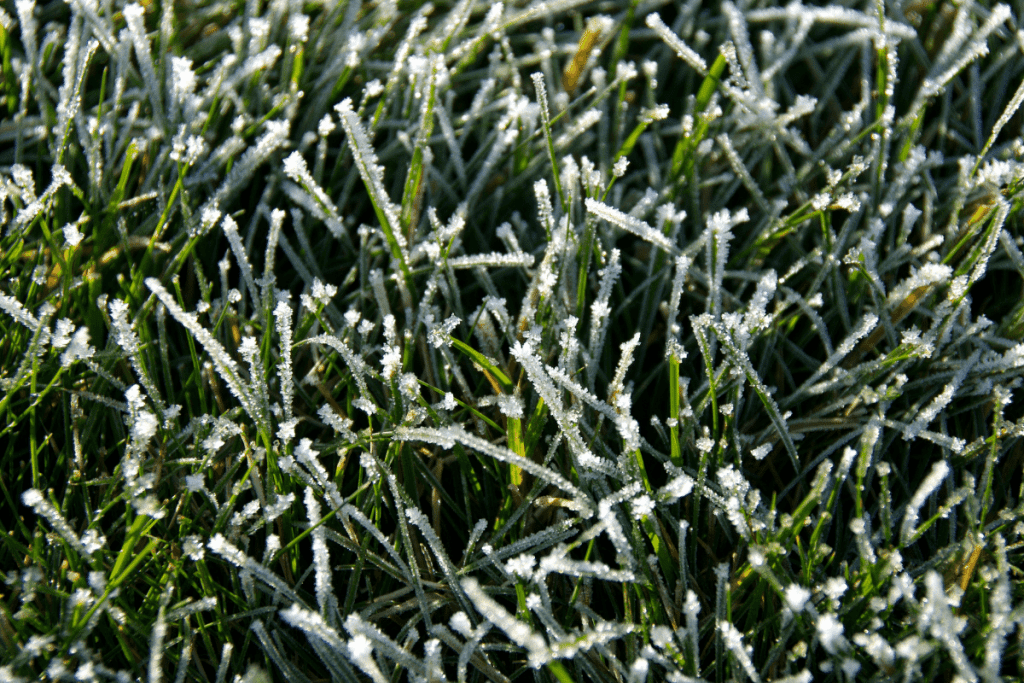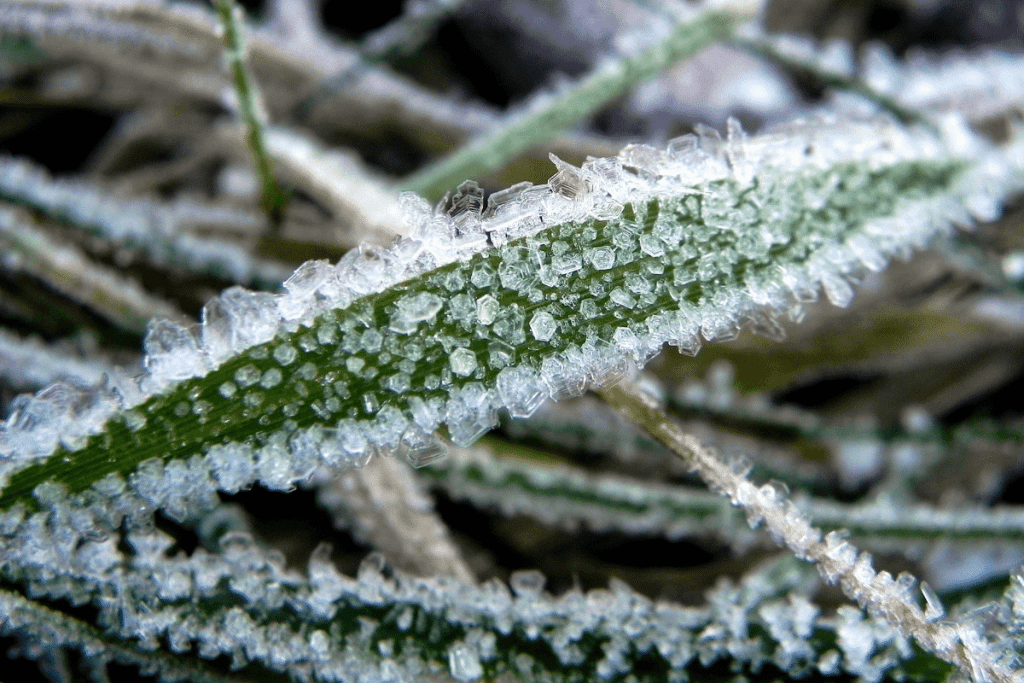Sometimes, the only way to get a lush, green lawn is to plant new grass seeds.
Whether filling in bare spots on your existing lawn or starting from scratch, you want your new grass to grow well and stay healthy.
If you planted your grass seeds late in the growing season, you might wonder if your new grass can survive the upcoming frost of winter.
New grass is more prone to frost damage because it has not developed a strong root system. However, with a few protective measures, your grass will be able to survive a frost without damage. These include:
- Water your lawn
- Insulate new grass
- Avoid walking on the lawn
- Apply fertilizer
- Avoid mowing after frost
Grass also deploys its safety measures by going dormant when temperatures get colder.
During this dormant period, grass does not actively grow, requiring fewer nutrients to stay alive.
The grass will usually turn brown during dormancy, but once warmer temperatures become more consistent in the spring, your lawn will return to its green color and resume growing.
Keep reading to learn more about protecting your new grass from frost and how to treat your lawn if it is damaged in the winter.

Table of Contents
How Does Frost Damage Grass?
When a frost occurs, water inside the grass blades freezes and expands, causing the cell wall to split open.
Under a microscope, the ice resembles tiny daggers, so any weight placed on the grass will cause it to become even more damaged.
Grass can survive a certain amount of damage above the ground.
The roots will store enough nutrients to heal the grass when the weather is warmer and grows again.
The longer a frost lasts, the harder the grass must work to heal itself.
Most grass goes dormant in cold weather, so it can focus on storing nutrients to protect and heal itself from winter damage.
Cold-season grasses are very resilient against cold temperatures, but warm-season grasses may not survive prolonged freezing temperatures.
Does Grass Seed Freeze?
If temperatures are low enough, grass seed will freeze.
However, freezing does not usually cause any damage to the seeds.
Much like fully-grown grass, the frozen seeds will simply go dormant.
The seeds will resume sprouting once temperatures are warmer.
The husk of the grass seed protects it from extreme temperatures and drought.
The grass becomes much more susceptible to damage after it has just started sprouting because it no longer has the husk to protect it.
Grass seed is also in danger if the ground freezes and repeatedly thaws in a short period.
This constant cycle of freezing and thawing may cause excess moisture in the grass seed and cause it to rot.
Is It Safe To Plant Grass Seeds Before Frost?
It is best to plant grass seeds at least 5-6 weeks before the first light frost of the winter season.
This timeframe allows the grass to become stronger by establishing roots in the soil.
If your grass seed does not have this growth period, it may be too weak to protect against freezing temperatures.
If temperatures are below freezing before the grass seed has had a chance to sprout, the seed will go dormant and wait until the weather is warm again before resuming growth.
It is safer for the grass seed if it has not sprouted before the frost because the seed hull will still protect it.
6 Ways To Protect Your New Grass From Frost

All is not lost if you expect a frost on grass you have recently planted.
There are several things to do to protect your new lawn from frost damage.
The earlier you take preventive measures, the better chance your entire lawn has of surviving frost and recovering quickly.
Water Your Lawn
One of the easiest ways to protect your lawn from frost is to give it a deep watering before colder weather settles in.
Watering your grass before a frost will help the ground stay warmer than the air around it.
The water in the soil will retain heat better than dry soil, making it more difficult for the ground to freeze completely.
By adding plenty of water to your lawn the evening before the frost comes, the water will be able to evaporate overnight slowly.
The evaporation produces a chemical reaction and creates warmth around your grass.
If your lawn does get a layer of frost and you are not able to melt it with a garden hose or sprinkler, avoid walking on your grass until the ice melts.
Insulate New Grass
If your grass is very new and there is a cold night with frost, it may be protected by covering it up.
Not raking the leaves from your lawn will provide some measure of protection.
Do not rake your leaves during a frost, as this will cause damage to your grass.
Peat moss is also an excellent choice for a cover, as is straw.
In a pinch, you may also use a bed sheet to provide a layer of protection to your lawn, and you will need to remove it the following day to allow the grass to breathe.
Do not use a heavy plastic tarp to cover your grass because the tarp might freeze and cause even more damage to your lawn.
Avoid Walking on Your Lawn
To prevent causing extra damage to your lawn, you will need to avoid walking on the frosted grass.
Any pressure applied to your lawn’s surface while covered in ice will cause a lot of damage.
Do not allow your dog to walk on the grass when it is frozen, either.
You may want to consider installing a driveway or sidewalk, so you are able to easily avoid walking on the grass.
Leave Your Grass Longer
The longer your grass is, the longer the roots will be.
If your new grass has had enough time to establish a robust root system, it will be better equipped to deal with freezing temperatures and frost.
If you stop mowing a week or two before the first frost, the grass length will offer your lawn some protection.
Longer grass blades will collect the frost before it reaches the ground, which means your grass will be warmer near the roots, essential for its survival.
Learn when your grass stops growing to know when you should stop cutting.
Apply Fertilizer
Fertilizing your lawn in the fall will offer a significant boost of protection to your grass.
The fertilizer will cause your grass to grow right before the winter comes.
The extra nutrients from the fertilizer will make your grass stronger and survive the cold winter temperatures.
Applying fertilizer is generally the last thing on people’s minds during the fall, but it is one of the most critical steps in your lawn care routine.
A nitrogen-rich fertilizer will provide your grass with the nutrients it needs to sustain itself during a frost, and it will also keep your lawn lush and green.
Avoid Mowing After a Frost
Frost will make grass blades very brittle.
If you mow your lawn when your grass is brittle, it will take longer for the grass to re-grow itself.
Only mow your lawn in the winter when temperatures are at least 40° degrees Fahrenheit (4° C) or higher.
Allowing your grass to stay longer in the winter will offer it some protection against frost, so there is no reason to mow your lawn when it is cold outside.
Ideally, your grass needs to be around 2.5″ inches tall in the winter.
If taller than this, mold may form when your grass is coated with frost.
When the grass is cut too short, it cannot complete photosynthesis properly because the grass blades are too short to absorb the right amount of nutrients and sunlight.
Short grass will also make the roots more prone to frost damage because they will not have much protection above the ground.
Treating Frost-Damaged Grass
If you did not take the proper precautions before the first winter frost and damage your lawn, there are a few ways to treat your lawn and help it recover.
Sometimes, damage to your grass is unavoidable due to a heavy frost.
Start by watering your lawn in the mornings to rehydrate it since water is lost in the freezing and thawing process.
If your lawn has developed mold after being covered in snow and frost, you will not need to water it.
Instead, the lawn will need to dry out as much as possible to prevent the mold from growing.
You will need to wait for at least one month before fertilizing your lawn because the nitrogen produced from the frost will cause even more damage to your grass when combined with the fertilizer.
If you have large areas of dead grass, the best option for repair is to have sod installed on your lawn when the ground temperature is warmer.
Sod provides an instant fix for bare spots without waiting for new grass to sprout.
If there are only small bare patches in your lawn after a frost, you may want to consider reseeding your lawn in the spring.
The soil temperature needs to be at least 60° degrees Fahrenheit (16° C) to reseed your lawn successfully.
Dethatching and aerating your lawn before reseeding will speed up the growth process.
Avoid using a pre-emergent herbicide when reseeding, or you risk killing your new grass before it even has a chance to sprout.
Lastly, you may want to consider rolling your lawn.
Check out our post on rolling your lawn to learn why it helps with reseeding.